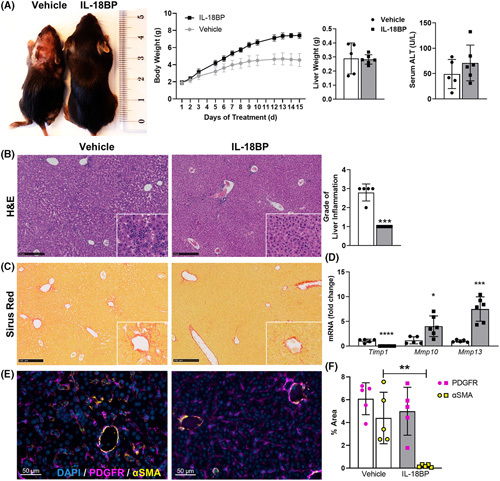FIGURE 6.

Treatment of Nlrp3 D301N CreL mice with IL‐18BP rescued highly inflammatory phenotype. Nlrp3 D301N CreL mice were treated with 6 μg/g rhIL‐18BP (Tadekinig Alfa) or PBS from day 2 to 14. (A) Growth impairment, rash, and reduced body weight, consistent with the phenotype of Nlrp3 D301N CreL mice, were clearly normalized by IL‐18BP treatment, whereas serum alanine aminotransferase (ALT) did not significantly change. (B) H&E‐stained liver sections and quantification showing less inflammation in IL‐18BP‐treated mice. (C) Sirius Red staining. (D) mRNA expression of ECM regulating enzymes (Timp1, Mmp10, Mmp13) were measured from total liver lysate. (E) Immunofluorescence staining and (F) quantification of PDGFR and αSMA showing more activated HSCs in the nontreated mice. αSMA, alpha smooth muscle actin; BP, binding protein; ECM, extracellular matrix; H&E, hematoxylin–eosin; HSCs, hepatic stellate cells; Mmp, matrix metalloproteinase; Nlrp3, nucleotide‐binding oligomerization domain leucine rich repeat containing receptor‐family pyrin domain‐containing 3; PDGFR, platelet‐derived growth factor receptor; Timp1, tissue inhibitor of matrix metalloproteinase 1; rh, recombinant human. n = 5–6 mice per group for all measured values; black scale bars represent 250 μm; *p < 0.05; **p < 0.01; ***p < 0.001.
